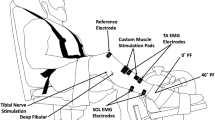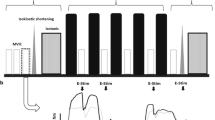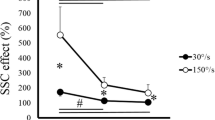Abstract
This study compares the fatigability of the ankle dorsiflexors during five sets of 30 maximal concentric and eccentric contractions in young and elderly adults. The torque produced by the ankle dorsiflexors and the average surface electromyogram (aEMG) of the tibialis anterior were continuously recorded. The contribution of central and peripheral mechanisms to muscle fatigue was tested before, after each set of contractions, and during a 30 min recovery period by the superimposed electrical stimulation method. The compound muscle action potential (M-wave), the mechanical response to single (twitch) and paired (doublet) stimulation, and the postactivation potentiation were also recorded. Compared with young subjects, elderly adults exhibited a greater loss of torque for concentric (50.2 vs. 40.9%; P<0.05) and eccentric (42.1 vs. 27.1%; P < 0.01) contractions. Although young subjects showed a lesser decrease in torque during the eccentric compared with concentric contractions, elderly adults experienced similar fatigability for the two types of contractions despite a comparable depression in the EMG activity of both groups and contraction types (10–20%). As tested by the interpolated-twitch method and aEMG/M-wave ratio, voluntary activation was not altered during either type of contraction or for either age group. During the two fatigue tasks, only elderly adults experienced a decrease in M-wave area (26.4–35.4%; P < 0.05). All together, our results suggest that the fatigue exhibited by both young and elderly adults during maximal concentric and eccentric contractions mainly involved peripheral alterations and that elderly adults may also have experienced a decline in neuromuscular propagation.






Similar content being viewed by others
References
Allman BL, Rice CL (2001) Incomplete recovery of voluntary isometric force after fatigue is not affected by old age. Muscle Nerve 24:1156–1167
Allman BA, Rice CL (2002) Neuromuscular fatigue and aging: central and peripheral factors. Muscle Nerve 25:785–796
Barclay CJ, Constable JK, Gibbs CL (1993) Energetics of fast- and slow twitch muscles of the mouse. J Physiol 472:61–80
Baudry S, Duchateau J (2004) Post-activation potentiation in human muscle is not related to the type of maximal conditioning contraction. Muscle Nerve 30:328–336
Belanger AY, McComas AJ (1981) Extent of motor unit activation during effort. J Appl Physiol 51:1131–1135
Bilodeau M, Henderson TK, Nolta BE, Pursley PJ, Sandford GL (2001) Effect of aging on fatigue characteristics of elbow flexor muscle during sustained submaximal contraction. J Appl Physiol 91:2654–2664
Carrasco DI, Delp MD, Ray CA (1999) Effect of concentric and eccentric muscle actions on muscle sympathetic nerve activity. J Appl Physiol 86:558–563
Cheng AJ, Rice CL (2005) Fatigue and recovery of power and isometric torque following isotonic knee extensions. J Appl Physiol 99:1446–1452
Clarkson PM, Newham DJ (1995) Associations between muscle soreness, damage, and fatigue. Adv Exp Med Biol 384:457–469
Constable JK, Barclay CJ, Gibbs CL (1997) Energetics of lengthening in mouse and toad skeletal muscles. J Physiol 505:205–215
Cupido CM, Hicks AL, Martin J (1992) Neuromuscular fatigue during repetitive stimulation in elderly and young adults. Eur J Appl Physiol 65:567–572
Ditor DS, Hicks AL (2000) The effect of age and gender on the relative fatigability of the human adductor pollicis muscle. Can J Physiol Pharmacol 78:781–790
Duchateau J, Hainaut K (1985) Electrical and mechanical failures during sustained and intermittent contractions in humans. J Appl Physiol 58:942–947
Duchateau J, Hainaut K (1986a) Nonlinear summation of contraction in striated muscle. I. Twitch potentiaion in human muscle. J Muscle Res Cell Motil 7:11–17
Duchateau J, Hainaut K (1986b) Nonlinear summation of contraction in striated muscle. II. Evidence of intensification of intracellular Ca2+ movement. J Muscle Res Cell Motil 7:18–24
Enoka RM, Stuart DG (1992) Neurobiology of muscle fatigue. J Appl Physiol 72:1631–1648
Gandevia SC (2001) Spinal and supraspinal factors in human muscle fatigue. Physiol Rev 81:1725–1789
Garner SH, Hicks AL, McComas AJ (1989) Prolongation of twitch potentiating mechanism throughout muscle fatigue and recovery. Exp Neurol 103:277–281
Grange RW, Houston ME (1991) Simultaneous potentiation and fatigue in quadriceps after a 60-second maximal voluntary isometric contraction. J Appl Physiol 70:726–731
Hainaut K, Desmedt J (1974) Effect of dantrolène sodium on calcium movements in single muscle fibres. Nature 252:728–730
Hunter SK, Enoka RM (2001) Sex differences in the fatigability of arm muscles depends on absolute force during isometric contractions. J Appl Physiol 91:2686–2694
Hunter SK, Critchlow A, Enoka RM (2004) Influence of aging on sex differences in muscle fatigability. J Appl Physiol 97:1723–1732
Hunter SK, Rochette L, Critchlow A, Enoka RM (2005) Time to task failure differs with load type when old adults perform a submaximal fatiguing contraction. Muscle Nerve 31:730–740
Jakobsson F, Borg K, Edstrom L, Grimby L (1988) Use of motor units in relation to muscle fiber type and size in man. Muscle Nerve 11:1211–1218
Jones DA (1996) High- and low-frequency fatigue revisited. Acta Physiol Scand 156:265–270
Kent-Braun JA, Ng AV, Doyle JW, Towse TF (2002) Human skeletal muscle responses vary with age and gender during fatigue due to incremental isometric exercise. J Appl Physiol 93:1813–1823
Klass M, Guissard N, Duchateau J (2004) Limiting mechanisms of force production after repetitive dynamic contractions in human triceps surae. J Appl Physiol 96:1516–1521
Klass M, Baudry S, Duchateau J (2005) Aging does not affect voluntary activation of the ankle dorsiflexors during isometric, concentric and eccentric contraction. J Appl Physiol 99:31–38
Komi PV, Linnamo V, Silventoinen PS, Sillanpää M (2000) Force and EMG power spectrum during eccentric and concentric actions. Med Sci Sports Exerc 32:1757–1762
Laforest S, St Pierre DM, Cyr J, Gayton D (1990) Effects of age and regular exercise on muscle strength and endurance. Eur J Appl Physiol 60:104–111
Lanza IR, Russ DW, Kent-Braun JA (2004) Age-related enhancement of fatigue resistance is evident in men during both isometric and dynamic tasks. J Appl Physiol 97:967–975
Larsson L, Karlsson J (1978) Isometric and dynamic endurance as a function of age and skeletal muscle characteristics. Acta Physiol Scand 104:129–136
Lindstrom B, Lexell J, Gerdle B, Downham D (1997) Skeletal muscle fatigue and endurance in young and old men and women. J Gerontol A Biol Sci Med Sci 52:B59–B66
Millet GY, Lepers R, Maffiuletti NA, Babault N, Martin V, Lattier G (2002) Alterations of neuromuscular function after an ultramarathon. J Appl Physiol 92:486–92
Pasquet B, Carpentier A, Duchateau J, Hainaut K (2000) Muscle fatigue during concentric and eccentric contractions. Muscle Nerve 23:1727–1735
Petrella JK, Jeong-Su K, Tuggle C, Hall SR, Bamman MM (2005) Age differences in knee extension power, contractile velocity and fatigability. J Appl Physiol 98:211–220
Russ DW, Kent-Braun JA (2003) Sex differences in human skeletal muscle fatigue are eliminated under ischemic conditions. J Appl Physiol 94:2414–22
Stackhouse SK, Stevens JE, Lee SCK, Pearce KM, Snyder-Mackler L, Binder-Macleod SA (2001) Maximum voluntary activation in nonfatigued and fatigued muscle of young and elderly individuals. Phys Ther 81:1102–1109
Sweeney HL, Bowman BF, Stull JT (1993) Myosin light chain phosphorylation in vertebrate striated muscle: regulation and function. Am J Physiol 264:C1085–C1095
Tesch PA, Dudley GA, Duvoisin MR, Hather BM, Harris RT (1990) Force and EMG signal patterns during repeated bouts of concentric and eccentric muscle actions. Acta Physiol Scand 138:263–71
Vandervoort AA (2002) Aging of the human neuromuscular system. Muscle Nerve 25:17–25
Vollestad NK, Sejersted I, Saugen E (1997) Mechanical behavior of skeletal muscle during intermittent voluntary isometric contractions in humans. J Appl Physiol 83:1557–65
Westerblad H, Lee JA, Lännergren J, Allen DG (1991) Cellular mechanisms of fatigue in skeletal muscle. Am J Physiol 30:C195–C209
Wersterblad H, Allen DG (1995) Relaxation, [Ca2+]i and [Mg2+]i during prolonged tetanic stimulation of intact, single fibres from mouse skeletal muscle. J Physiol 480:31–43
Acknowledgments
The authors are particularly grateful to professor R. Enoka for comments on the paper and to A. Desseir for assistance in the preparation of the manuscript. This study was supported by a grant of the European Community (contract: QLK6-CT-2001-00323) and the Fonds National de la Recherche Scientifique of Belgium.
Author information
Authors and Affiliations
Corresponding author
Rights and permissions
About this article
Cite this article
Baudry, S., Klass, M., Pasquet, B. et al. Age-related fatigability of the ankle dorsiflexor muscles during concentric and eccentric contractions. Eur J Appl Physiol 100, 515–525 (2007). https://doi.org/10.1007/s00421-006-0206-9
Received:
Accepted:
Published:
Issue Date:
DOI: https://doi.org/10.1007/s00421-006-0206-9




